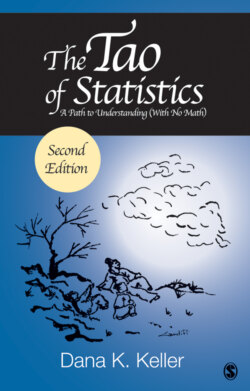Читать книгу The Tao of Statistics - Dana K. Keller - Страница 14
На сайте Литреса книга снята с продажи.
5.A. Nominal
ОглавлениеNominal says different
No more does it claim
Others shouldn’t either
The nominal level of measurement is about categories. Some statisticians refer to it as the categorical level of measurement. The categories have characteristics that differ but are not quantified as to the amount of the difference. For example, political party, religious affiliation, gender, and so forth can be recorded, grouped, and counted. Yet we do not say, for example, that one religion is more of a religion than another.
Under certain conditions, the most typical type of average, the mean (i.e., arithmetic average), is appropriate for nominal data. That is, the variable has only two possible responses, and talking about the percentage that corresponds to one of those responses makes sense. With gender coded 0 for female and 1 for male, it would make sense to use the mean to say that a group is 60% male.
Variables coded and interpreted as we have just seen find use in a variety of statistical techniques requiring at least interval levels of measurement (a discussion about interval level data is coming shortly). Some nominal data, therefore, can be quite useful in answering a surprisingly broad range of questions.
Both the high school principal and the director of public health have nominal data. The high school principal has data on gender, school club membership, sports participation, and scholastic topics for each student. Some aspects of these measures could be coded as nominal, such as variables for the names of extracurricular activities (e.g., yearbook).
The director of public health has access to a host of demographic data that are nominal, such as ethnicity and zip code. Generally, nominal data are summarized in tables or cross-tabulations of two characteristics, such as sports participation by gender or immunization rates by age or age grouping. Nominal data also delineate many of the groups of interest to research. Nonetheless, even in her naming of variables, she needs to be careful of racial and ethnic sensitivities (e.g., should a category be Black, Black American, African American, or combined with other categories into Americans of Color?) or some stakeholders could be offended and not pay attention to the point of her report.
